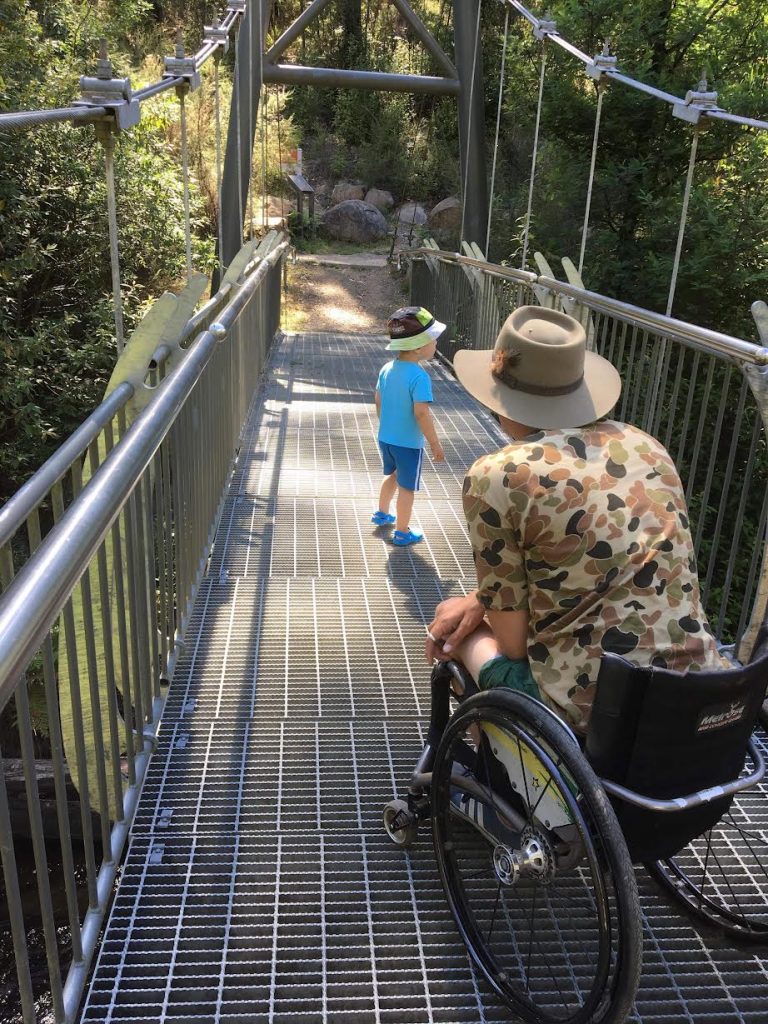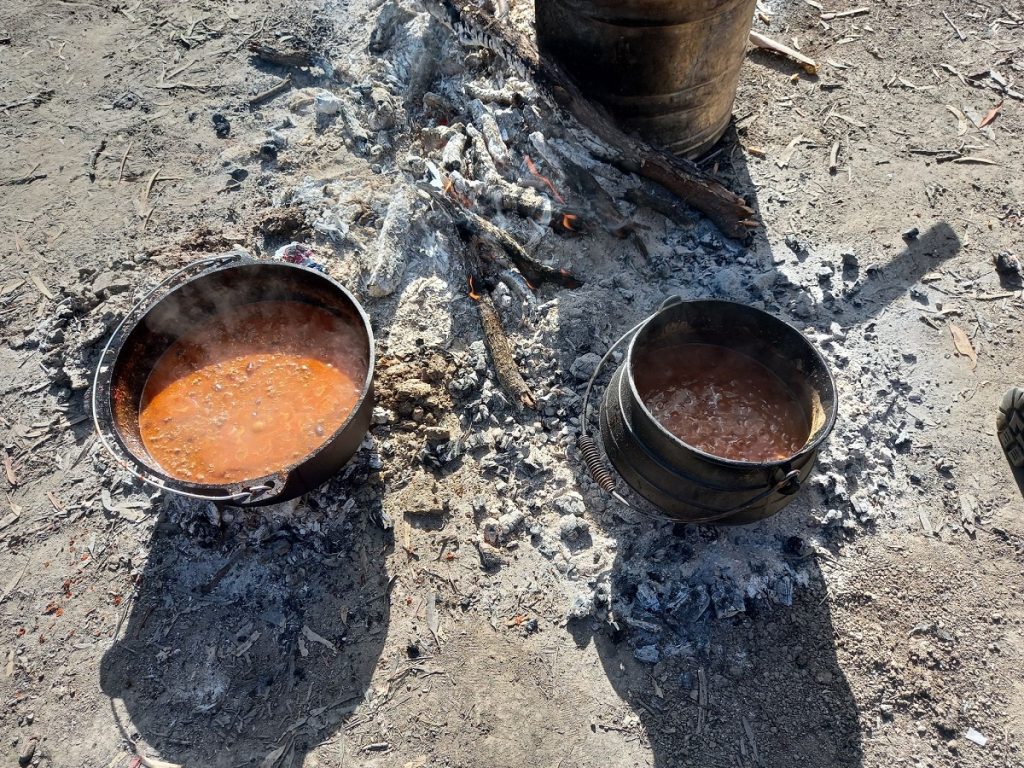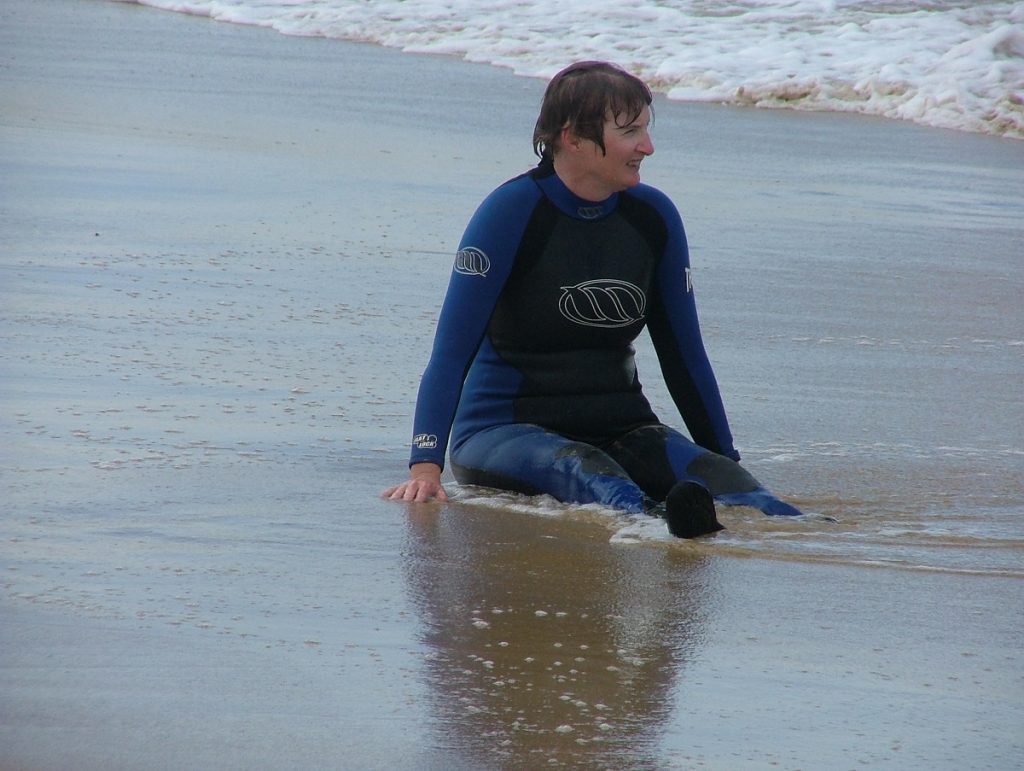As the weather is improving, we ran a panel discussion on all things camping and outdoors. The following is a summary of some of the presenters’ thoughts and experiences, structured as mini profiles. First up, hear how community members do camping and outdoor activities differently, and pick up some tips along the way. Then, listen to a few people working in the recreation and assistive technology fields talk about resources to help you plan your own adventure. Dip into the people and experiences that are relevant to you, or enjoy it all.
Lived experience

Injury level/years post: C5/6 quad, no finger function and limited arm function, 34 years
Activities: Handcycling, kayaking, camping, and flying
Handcycling:
Handcycling is really accessible – once I’m in, I can head off on the trails around Melbourne on my own. I use a Lasher handcycle, and I installed a power assist which allows me to go up any hills and through sand. It really opens up the world for me. The longest trip I’ve done was from Melbourne to Broken Hill.
Kayaking:
In 2016 I paddled the length of the Murray, in 89 days. I used a sea kayak with a nice big cockpit. I put some outriggers on it for balance, side supports to keep me balanced, a sip/puff system to control the rudder, and I taped my hands to the oar with duct tape.
Camping style: Taj Mahal
Shelter:
I’ve got a four person Blackwolf tent, with lots of head room, and enough width for carers to help me with my morning routine. I use a self-inflating mattress with a latex topper, on a cot, so it’s very comfortable and I haven’t had any issues with my skin. I’ve also got a bed made for the back of my van, which I use on some trips.
Other gear:
On the kayak trip, I borrowed a generator, which meant I could use a blow heater in my tent – I hate the cold, as a lot of quads do. For the same trip, I made up a kit that meant I didn’t have to take a commode – which I now use for any trip. I take the upholstery off my wheelchair, clip a toilet seat on my chair, a bucket underneath, and then a plastic bag on the backrest so the upholstery doesn’t get wet. It only takes a couple of minutes to set up, and the kit takes up very little space.
What you love about it:
Nothing better than having a fire on the side of the road, pitching camp and watching the stars.
Tips:
- Outdoor adventures can be big or small. With a little bit of planning, and the right support, anyone can get out and have some form of adventure.

Injury level/years post: C6/7 quad, 18 years.
Activities: fishing, shooting, hunting, and camping.
Camping style: rough and ready when solo, comfortable with the family
I’m the opposite to Dave’s Taj Mahal approach. My idea of camping is putting the portable fridge in the back of the car, throwing the swag in the trailer, and going and sleeping on the ground under the stars. Then I met my wife, and she likes camping, but she’s not a fan of the hardcore stuff. So we got a camping trailer, which we take on family camping trips.
Shelter:
Solo: Swag, plus self-inflating mattress, total thickness: 150 mm
With family: Camping trailer. It takes a bit over an hour to set it up, but once we’re set up it’s perfect. I sleep in the main tent in a stretcher, on a self-inflating mattress.
What you love about it:
I’ve always been very outdoorsy, I just loved being in the bush. I found I could get rid of a lot of stress there. After my accident, I didn’t think I’d be able to get out there anymore. So when I realised I could, it really gave me all this energy, and the feeling of being able to fend for myself was great. Now I have a son, being able to take him out on bushwalks is really good.
Tips:
- The heat and the cold can be a big factor when you’re camping. You really need to work out well in advance where you’re going, what facilities are available – is there water to cool down if it’s really hot, will there be space for a fire to keep warm at night. When you’re buying a sleeping bag, always go with a lower temperature rating. Once that’s all figured out, the sky’s the limit.
- My best advice is to just get out there and give it a go – even if it’s in your backyard – buy a tent, set it up, and try it out. And if you hit problems, just brainstorm it. Once you get out there and find something you love, you’ll want to do it more, and you’ll find ways to make it easy for you.

Noel McKenner (59)
Injury level/years post: C6 quad, 32 years.
Activities: camping, camp cooking, fishing
Camping style: old school but comfortable
Shelter:
Early on, post-injury, I tried doing an overnight fishing trip. I slept in the car and I almost froze to death. So, I tracked down an old canvas tent. I designed and built my own slatted bed with a proper mattress and adjustable legs, like caravan jockey wheels, which I can jack up with a drill.
Other gear:
- A home-made hot water service. An old keg with pipes running through it, sits next to the fire – you pour cold water in and hot water comes out.
- We’re in the process of building a hoist with pneumatic wheels – I’m getting a bit long in the tooth to be transferring and knocked about.

What you love about it:
Taking the grandkids out, spending the days building memories with them. Getting their bums walking around and doing stuff, staying out of trouble, learning how to help each other and be supportive. I’ve always been the camp cook wherever I’ve gone – I teach the kids and the grandkids, they’re all having a crack with the camp oven. We do heaps of roasts, and we even made cinnamon scrolls recently. It’s very rewarding.
Tips:
- It’s just about finding a good spot, with a good flat bank to go fishing. Get a fire going and just enjoy it.

Lynne Panayiotis (59)
Injury level/years post: T12 para, 16 years.
Activities: Touring, bowls, bodyboarding, handcycling.
Camping style: Comfortable
Shelter:
I’ve done the tent thing, and like Andrew I’ve done the camper trailer, which I loved, but I couldn’t put it up by myself, and independence is really important to me. That, combined with wanting a toilet and shower, was why I moved on to a caravan.
When I was injured in 2006, I had the goal of travelling around Australia in 2008. I haven’t made it yet, but the ambition is still there: I have the caravan, and I’ve got the car on order. I intend on spending my long service leave travelling around Australia.
The caravan is on air bags, so it drops down, and a ramp comes out. I’ve travelled up to Canberra by myself, so I know I can hitch and unhitch, set up and packdown by myself.
What you love about it:
The feeling of being an explorer.

Tips:
Cars can’t tow as much as they used to, especially wagons that we can get into easily. So if a camper trailer or a caravan is something you’re interested in, you’ll probably need a van.

Simon Bibby (49)
Injury level/years post: T11 para, 2.5 years
Activities: camping
Camping style: basic
Shelter: I’ve got a camping cot – about 50ml below my wheelchair seat, so it’s not hard to transfer into. I’ve got some shoulder issues, so the height transfer is critical. The cot is called The Bunker, a Dune product from Anaconda. It’s a double, so you’ve got two narrow spots for sleeping, or you can store your clothes.
Other gear: I’ve got a Batec Scrambler for my wheelchair. I took it on a recent trip up to the Rubicon with a mate, which meant I was able to go along rough terrain with him.

What you love about it: I’ve always been an outdoors person – sailing, skiing and whatnot – so it’s been frustrating being in a chair. But then last year I went away with some mates. I was very apprehensive about it at first, but I got through that and it was great.
Tips:
- In my experience, friends will go above and beyond to help – ask them to join you on a trip.
- Be prepared: if you think you need two packs of baby wipes, take four
Industry perspectives
Amber Smith
Role: Access and Inclusion Coordinator at Parks Vic
The Pitch: Stay abreast of accessibility upgrades happening in Victoria’s parks.
The Victorian Great Outdoors program is a four-year $100 million project to improve how people can access the great outdoors. Part of what this project has allowed us to do is to maximise the accessibility of all the amenity and trail upgrades being undertaken by building in universal design principles early. While many of these works are underway or in planning, some have been completed, and there are accessible trails and campsites in Victoria you can explore right now. To see what’s possible for you, check this collection of accessibility resources on our website: https://www.parks.vic.gov.au/get-into-nature/all-abilities-access
Or reach out to me for a chat:
0438 544 218
Allison von Moger
Role: Technology and Innovation Lead at TOM Melbourne
The Pitch: Meeting unmet needs through innovation
At TOM Melbourne we run a program to design assistive technology for people with a disability. We’re currently working with Parks Vic to develop an accessible camp bed, as part of their Point Nepean accessible campsite project.
TOM, or Tikkun Olam Makers, is a global movement that started in Israel. The name roughly translates to ‘repair the world’, which TOM communities attempt to do in small ways by developing affordable solutions to neglected challenges. If you have an unmet need that’s limiting your ability to explore the great outdoors, and you think some custom assistive technology might do the trick, submit a challenge on the TOM website and we might be able to help.
Learn more at www.tommelbourne.org
Or get in touch at [email protected]

Elysia Gustafson
Role: FishAbility Facilitator with Fishcare Victoria
The Pitch: Get fishing!
Fishing is one of the most accessible sports that you can imagine. I know that a lot of sports can be made adaptive, but fishing can be done from the age of three, up into your nineties. All you need is a body of water, and a fishing rod, which can be adapted if need be, and you’re off and away.
We deliver all ability fishing programs about once a month, between September and May. The programs have been largely metro focussed, hosted along the Maribyrnong River and on the St Kilda and Mornington piers in Port Phillip. But we’ve also done programs all over regional Victoria, and hope to expand that focus.
We’ve got battery powered reels – which allows for the retrieval of your bait, or, best case scenario, a fish, with the press of a button. They can attach to any rod. And we’ve got a strong arm, a device which helps to keep the rod secure against the forearm. With these simple pieces of equipment, the benefits of fishing – physically, mentally, and spiritually – are available to people with a wide range of mobility.
Learn more about our programs or throw us line at: https://fishability.fishcare.org.au/#contact

Nicole Gosbell
Role: Austin Leisure Specialist
The Pitch: Start small, and take the time to explore your options and resources
The range of outdoor activities is so broad, and the way people participate is so broad – there’s no right or wrong way of doing it. It’s just about taking the time to work out what you want to do, and how you want to do it. Then you start looking at what options and resources you have available.
It’s good to start small if you haven’t done it in a while, or you’re new – you can start in the backyard.
You need to think about temperature, and whether you’ve got shade. In a tent you’ve got to think about insulation. If you’re on the ground, different mats have different R ratings, which tells you how much insulation they provide, and how much warmth they provide. Having a mat on a stretcher can help, or having insulation across the whole floor of the tent can help. Think about how you move, if you need pillows for support, how can you use the zip to get in and out.
For a smaller tent, swags on top of stretchers are a common approach. For something more spacious, some people like using air tents, where the poles are like bike tubes that you pump up. If you want to be able to keep your chair dry overnight, make sure you get a tent with an awning. For all this gear, try it out beforehand, in the shop and your backyard.
Personal care while camping is a common question. There are so many ways I’ve heard people manage it. Dave had the insert for his wheelchair, other people might use a commode over a bucket, or a campground where there’s an accessible toilet, so it’s really about what works for you. It’s good to talk to an occupational therapist if you need something specific.

- October 24, 2022




